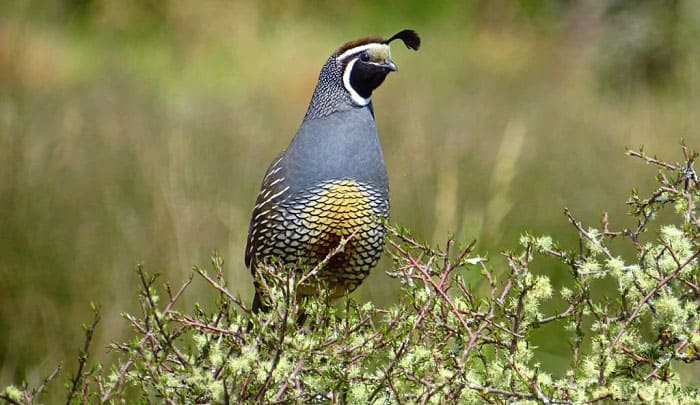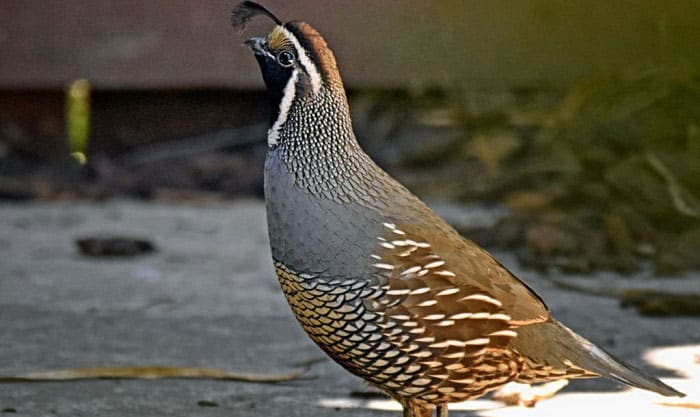Well, it is an adorable quail with a plump physique, but its adaptability is outstanding.
In fact, the California quail is a popular prized game avian. Known also as valley quails, these bird species are mostly found in California, mostly in shrubberies, grasslands, and mainly on the ground. The California quails love to stay in flocks, typically consisting of at least 60 birds.
Want to know more about this California state bird? If yes, read on, as we have gathered a couple of facts showing what is the state bird of California and how this bird is more befitting as a state bird.
Table of Contents
The CA’s State Bird: California Quail
Scientific Classification:
- Kingdom – Animalia
- Species – C. California
- Family – Odontophoridae
- Phylum – Chordata
- Class – Aves
- Order – Galliformes
- Genus – Callipepla
- Binomial name – Callipepla californica
It was on August 14, 1931 when the California quail bird was officially recognized as the state bird of the Golden State.
It came to pass thanks to Assembly Bill 776, which also made the California quail the avifaunal symbol of the state, known as the California valley quail or simply valley quail.
The state bird favors the ground. And bird enthusiasts can hardly miss this avian species because of their distinctive teardrop-shaped head called the topknot.
Physical Attributes Of Valley Quails:
- Wingspan – 32-37 cm
- Weight – 140-230 grams
- Length – 24-27 cm
- Head – teardrop-shaped
- Tail – short; brown and gray shades
- Plumes – black for males, brown with white traces for females
- Belly – black and brown
- Toe – facing backwards, which is called hallux
California’s state bird is blessed with an arched arrangement of six feathers. The males have black plumes, while the female quails have brown feathers with white steaks.
As highly sociable avians, the California quails have a habit of getting together. Their small circle of flocks is called ‘coveys’. And one of their favorite activities is to indulge in a dust bath while it’s sunny.
The breeding months of the California quails are May, June, and July. Compared to humans, this bird species is polyamorous, and the females and male birds live together with their young. Each female can lay 12 to 16 eggs per partner, with an incubation time of 22 to 23 days before hatching. And the lifespan of the valley quails is up to four years.
Interesting Facts About the California Quail Bird
Fact #1: “Chicago” call
One of the most interesting California state bird facts is their “Chicago” call. Bird lovers can easily recognize the valley quails thanks to their singing resembling chi-ca-go.
Aside from that, the male birds also sing something like ”put way doo” repetitively and nasally, as well as a relaxed “waay” or “waaaaw”. Furthermore, male valley quails also emit sounds like “spwik wik wik”, “pi-pit”, and “ut, ut”.
Fact #2: Adult quail poop
The young California quails are called chicks, and unlike other newly hatched birds, the chicks feed on adult quail poop.
It is because the droppings of the adult birds contain a specific organism that is beneficial for the digestion process of the chicks. The young quails need to ingest this particular organism to better digest vegetation and acquire the mechanism from the adult birds.
Fact #3: Human pets
California’s official state bird is the California quail, and this avian species is beautiful enough to become human pets. Indeed, it is not illegal to make this kind of bird a house pet, but only if the valley quails come from a breeder. Wild birds may carry diseases, so purchasing domesticated California quails is safer.
Fact #4: Predators
The California valley quails are fond of eating seeds, flowers, berries, small insects, and snails. They are indeed predators in their own right, but they are also prey to larger animals.
The most common predators of the California quails are the bobcats, snakes, domestic cats, coyotes, skunks, great horned owls, and squirrels.
Fact #5: Dust bathing
The California quail birds love to perform what they call a dust bath. A small flock of valley quails will find a soft ground and dive an inch or two into the soil through their underbellies.
And then they flap and ruff their plumes which leads to the flying of dust. In fact, thanks to their dust bathing, birders can easily spot the happy place of the California quails by the look of a 2.8-5.9 inches indentation on the ground.
Fact #6: Flushing
The Cali state bird favors walking rather than flying. They are often seen at various roadsides, feeding on their favorite meals, leaves, and seeds. However, when the valley quails are startled, they engage in a momentary speedy flight called “flushing”. But in many cases, the valley quails escape on foot rather than by flying.
This kind of avian has a ground speed of 19.3 km per hour. Literally running away is made easier by their short and strong legs. And when in flight, the valley quails can accomplish up to 93 km per hour.
Fact #7: Communal Broods
California valley quails are known to create multi family that is referred to as “communal broods”. This means that in one breeding spot, there are usually at least two female valley quails, numerous men, and dozens of young birds.
The female quails habit laying eggs fathered by one associated male and then moving on to another male partner to lay another batch of eggs. The females often leave their young to males who are not genetically related to the hatched birds.
Fact #8: Chicks
The CA state bird, the valley quail, produces young that are referred to as chicks. After hatching, the little birds can walk and peck already. They don’t stay at their nests, but rather start exploring their surroundings. At 10 days old, the chicks attempt to test their flight skills.
The young California quails wander the ground for 30 days. And then they perch on trees together with the adult birds.
Conclusion
The answer to the question of what is the state bird of California has been provided. We hope you learned more about the valley quails and use the new information on your bird watching adventures. Unquestionably, this type of bird species deserves to be admired, treated well, fed in your backyard, and respected.
Kindly share this post on your social media so others may learn of the interesting facts about the California quails. And if you have additional questions or want to share your thoughts, please feel free to let us know through the comment section.
In addition, discover our article about other state birds like:
- Some interesting facts about the greater roadrunner of New Mexico.
- State bird of Massachusetts and their facts.
- What is the state bird of Alaska?

George and I became friends after a birdwatching trip with our new group. And we have been enjoying every adventure together. When he told me the idea of establishing a site that shares our experiences and fun, I immediately agreed. After trials and errors, here we have Thayerbirding.
















